
In this drawing lesson, we'll take a look at rendering a feather with graphite pencils. The approach explored here can be applied to any subject and many of the principles are relevant to drawing any subject. Drawing a feather is an excellent exercise for developing your understanding of texture and how it is communicated through value and line.
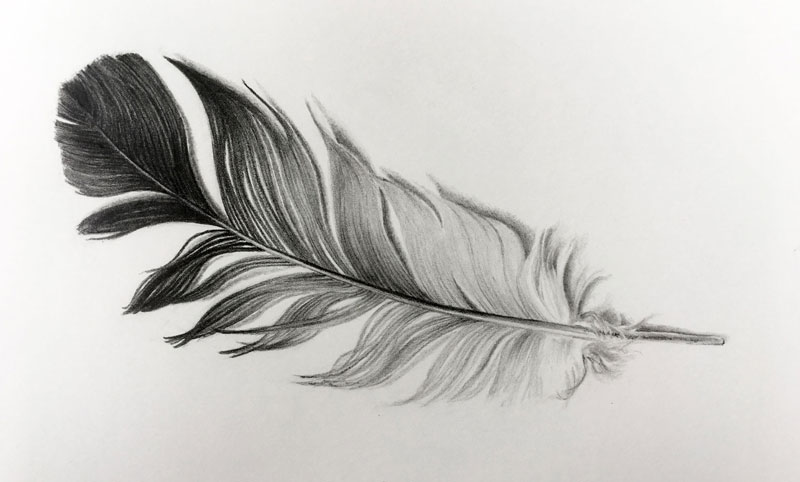
(Some of the following links are affiliate links which means we earn a small commission if you purchase at no additional cost to you.)
We'll use three graphite pencils to develop the shape, value relationships, and texture of the feather. The pencils that you choose may vary depending on the amount of pressure that you naturally place on the surface as you draw. In this example, "H", "HB", and "4B" pencils are used. The "H" pencil is applied in the early stages with a light touch. As the values are developed, the slightly darker "HB" and much darker "4B" pencils are used.

The surface texture of the paper will always play a role in the texture that is produced within the drawing. Because the goal is to create smooth transitions of value in this drawing, a paper with a weaker tooth is used. Smooth Bristol paper makes a suitable surface, although any drawing surface with a smoother surface will do.
Blending stumps are also used to smooth graphite applications. Blending stumps are simply pointed sticks of compressed paper. Blending stumps allow the artist to work the graphite into the tooth of the paper, creating an even distribution of the material. Since they are pointed, the artist has more control over the resulting mark. Blending with a finger is discouraged since you have less control and the oils from your finger can produce an uneven distribution of the medium.
It's suggested to create your drawing by looking at a feather. This may be a photo or perhaps a feather that you've found. Observation is important. By studying our feather visually, we're provided with all of the information we need to complete the drawing.
The drawing begins by first establishing a line for the center shaft of the feather which is called the "Rachis". The length and curvature of this line varies depending on the type of feather. In almost all cases, this line will curve slightly.
Light, sketchy lines are used to "find" the curvature and length of the line with the "H" pencil. It may be helpful to draw this line in segments, if you find that it's difficult to capture the curve.
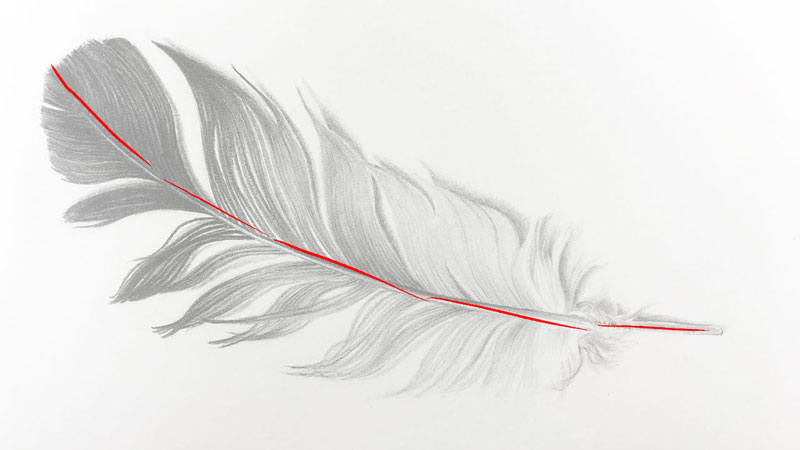
Using this initial line as a guide and for comparison purposes, we can draw the outer contour of the feather. At this point, we aren't concerned with the smaller shapes that happen within the body of the feather. Again, light and sketchy lines are drawn to "find" this shape.
With our subject, the space between the center line and the outer contour of the feather remains fairly constant. For some feathers, this outer contour line will be quite varied. It may taper in areas or become smaller. Each feather is different - even ones that originate from the same bird.
Again, you may find it helpful to draw this contour line in segments. Don't allow yourself to become overwhelmed by the smaller details. We're only concerned with the larger shapes at this point.
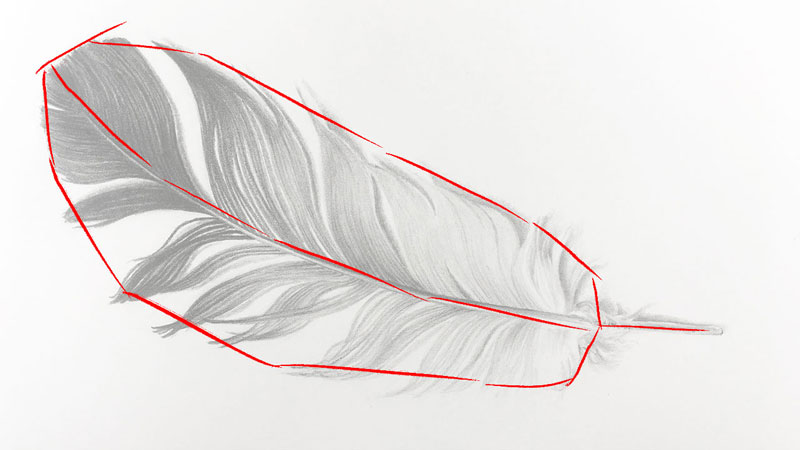
With the outer contour defining the shape of the feather in place, we can now focus on the smaller shapes within the body. The smaller "hairs" of the feather are called "barbs". Collections of barbs on the feather are tightly compacted in areas. But in other locations, they are sparse. Each shape that is formed by the tightly compacted barbs forms a shape that is similar to a flattened "s". These shapes are defined with light marks made with the "H" pencil.
It's important to think of these collections of barbs as a simplified shape. We'll develop the linear features of the barbs in a moment. Again, just concentrate on general shapes.
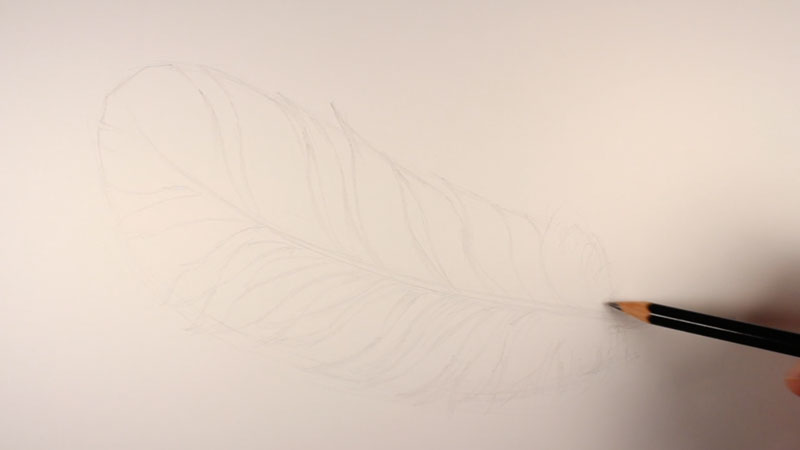
Now that the smaller shapes within the feather are defined, we can begin the process of developing the value and texture within each collection. Marks are pulled outward from the rachis, extending out to the end of each shape. These directional strokes mimic the overall shape of each collection of barbs. An "HB" pencil is used initially before blending with a blending stump.
The blending stump lightens the value slightly while softening the pencil applications. The "4B" pencil is used to darken values after blending occurs, creating darker tones and increasing the contrast.
As we broaden the range of value and increase the contrast, the texture of the feather begins to emerge. Visual texture is heavily dependent on two factors: the directional stroke and value. The texture is therefore developed as we push the value range, making directional strokes with the pencil.
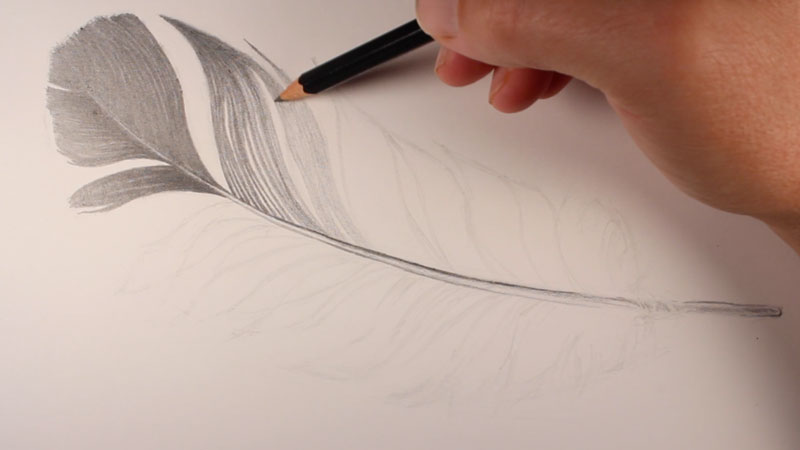
We'll continue with this process working down the body of the feather. In this case, the feather becomes progressively lighter in value closer to the quill (the base of the feather). For this reason, the amount of graphite and the pressure placed on the pencil is adjusted.
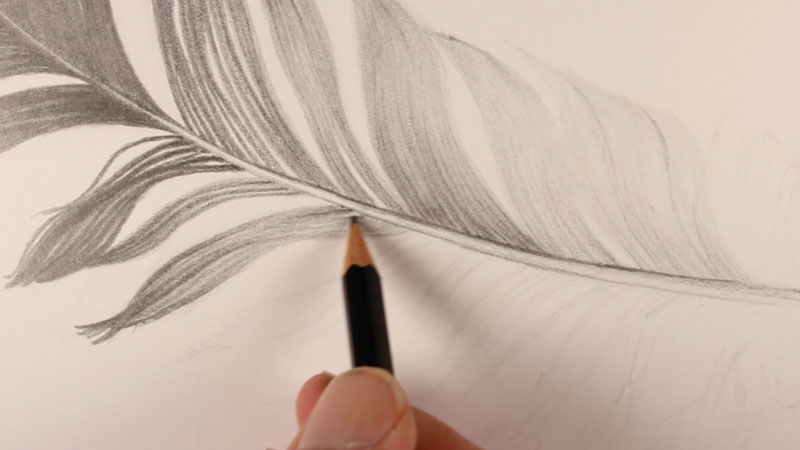
The upper portion of the feather consists of stiffer, rigid barbs, but the lower portion is made of softer, wispy ones. Additionally, the barbs on the lower portion are very light in value. To reflect this, these barbs are defined by drawing the weak shadows around them with the "HB" pencil and softly blending with the blending stump.
This slight contrast creates the impression of the smaller and lighter barbs by using the white of the paper.
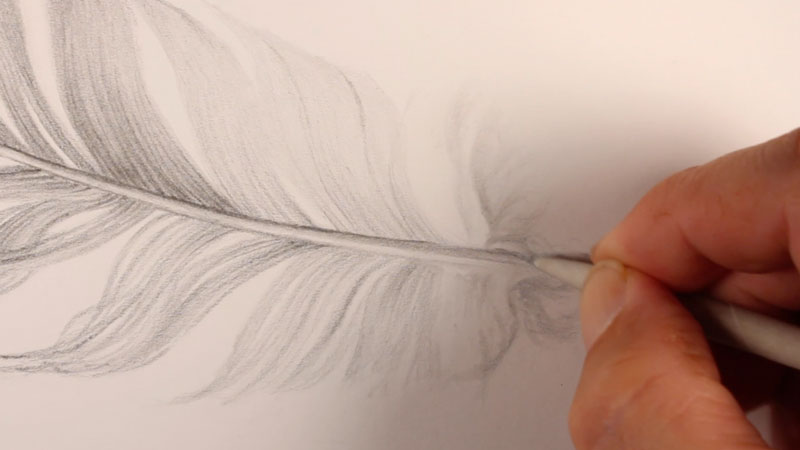
Next we'll add a bit of cast shadow on the surface, underneath and behind the feather. An "H" pencil is used since it provides greater control of the transition of value from dark to light. These cast shadows are darker closer to the feather but fade quickly. Since the light source originates from the lower left, these shadows mainly exist behind the feather above and to the right.
In this case, our feather doesn't rise very far off of the surface. This means that the cast shadow is fairly short and doesn't extend very far from the edge. However, if you use your own resource, you may find that your feather is more curved or the light source originates from a different location. If this is the case, then your cast shadow may extend further and create a completely different shape. Again, it's important to pay attention to your subject and the shapes that the shadow create on the surface.
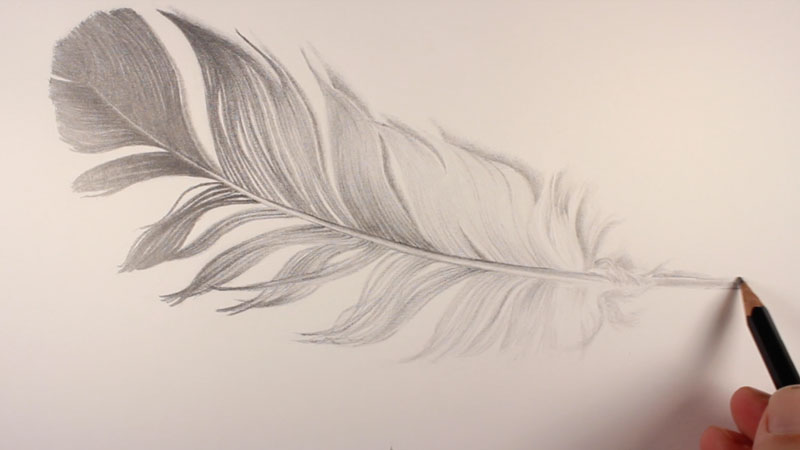
To complete the drawing, the shadow on the upper portion of the rachis is strengthened with a strong application of the "4B" pencil. This makes the rachis stand out and gives it the impression of form.

As mentioned before, drawing a feather is a great exercise for developing your skills for capturing texture. It's a simple process - draw the rachis (shaft) with a simple line, define the shapes, and then develop the value and texture with directional strokes.